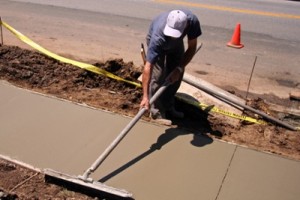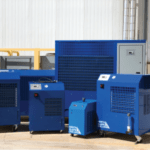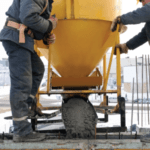Pouring concrete in hot weather is a tricky endeavor. We all know that summer is the ideal time for construction projects. Managers and crews begin the season eager to maximize the longer daylight hours and the warmer weather. With the threat of fall and winter looming, the clock is ticking all summer to accomplish as much as possible. It is true that fewer concrete problems exist during the summer. However, excessively hot temperatures can cause problems as well.
Hot Weather Concrete Problems
When the summer months get really hot, it can be a little too much of a good thing. In fact, concrete cures best in a range between 70° to 80° F. As your temperature approaches 90° F, however, you’ll start to run into problems. “Hot weather” is more than just temperature. Days of low relative humidity as well as days with high wind speeds also are grouped into “hot weather.”
Finishing Difficulty
Concrete sets much faster on hot weather days, making it very difficult to level and finish smoothly before it becomes set. Your finished slab is more likely to have surface deformities and unevenness unless precautions are taken.
Decreased Setting Time
Freshly poured, fluid concrete mixtures can be molded with strategically spaced control joints. These joints help control random cracking as the material hardens and shrinks. During hot weather, your mix sets much quicker and there is less time to place these joints correctly.
Reduced Strength
Your slab becomes set during the hydration process, when water is absorbed and crystals are formed. Cooler concrete takes more time to hydrate and has more time for these crystals to form and strengthen. In hot weather conditions, this process is truncated and the mix has less time to hydrate, form crystals, and set to a strong compressive strength. Because of this, hot weather concrete is more likely to suffer decreased strength and durability.
Increased Cracking Risk
Hot weather, wind, and dry conditions all lead to an increase of evaporation. These environmental factors pose a real threat to the top layer of your slab. As water is leached out of the surface layer by evaporation, the mix can become too dry and is more susceptible to surface cracking.
Drying Shrinkage
Even under normal conditions, the volume of a wet slab will be different than that of a dry slab. This volume change is even greater when pouring concrete in hot weather. Increased evaporation is the biggest culprit behind the shrinkage of a slab. The temptation to add more water to a mixture can also create shrinkage. The wetter a mix is, the greater the volume change when set.
Hot Weather Concreting Tips
Dampen Your Subgrade
During a pour, water is immediately leached out of your concrete and into the surface you are pouring on top of. Lightly hydrating the surface before you pour can help keep moisture in your mix during the hydration process.
Time Your Pour
During hot conditions, pours should be scheduled during the coolest part of the day. Most likely this time frame will fall in the morning hours. If your concrete is being mixed off-site and then delivered, make sure you avoid timing your deliveries during peak heat.
Chill Your Water
Chilled water can reduce concrete temperature by up to 10° F. Having an industrial chiller on hand to chill your water before mixing will give you a great advantage over mother nature.
Admixtures
Concrete admixtures can greatly improve the strength, manageability, setting time, and quality of your mix. Consider using hot weather admixtures, like recycled plastic additives, that will make your mix easier to work with, and increase its setting time so it can cure to a greater strength.
Reduce Mixing Time
Once water has been added to the mix, reduce your mixing time. Over-mixing will create more water loss through evaporation.
All Hands On Deck
Schedule your crews so that you have as many hands as possible when pouring in hot weather. Due to faster set times, you will need as much manpower as possible to place forms, prep your sub-grade, smooth, set control joints, and level while your mix is still workable.
Use Sunshades and Windbreaks
Closely monitor sun patterns and wind forecasts so you can keep your concrete protected from the elements. Placing sunshades and windbreaks can greatly decrease the threat of evaporation and give your slab more time during the hydration process.
Powerblanket Concrete Solutions
Powerblanket specializes in total temperature control. It is critical during temperature sensitive endeavors like concreting, to have the tools on hand to keep your temperatures where they belong. Learn more about using concrete blankets during the winter here, or process cooling during the summer with North Slope Chillers.
No matter the temperature, the Powerblanket family has your concrete needs covered. Contact us to find the perfect concrete solution for your needs 866.957.5538 or [email protected]
Frequently Asked Questions
What happens if you pour concrete when it’s too hot?
Pouring concrete in excessively hot conditions can lead to rapid moisture loss, causing plastic shrinkage and thermal cracking, which compromises the structural integrity of the slab.
At what temperature should you not pour concrete?
Concrete should ideally be poured when temperatures are between 50°F and 85°F, as temperatures above 90°F can accelerate setting and reduce strength, while temperatures below 40°F can hinder the hydration process.
What is the heat limit for concrete?
The American Concrete Institute suggests that the maximum temperature for concrete after placement should not exceed 160°F to prevent thermal cracking and ensure proper curing.
How to pour concrete on a hot day?
To pour concrete on a hot day, schedule the pour during cooler parts of the day, use sunshades and windbreaks, chill the mixing water, and consider using admixtures to slow the setting time.
Cure your concrete faster and better in cold weather conditions with Powerblanket.





